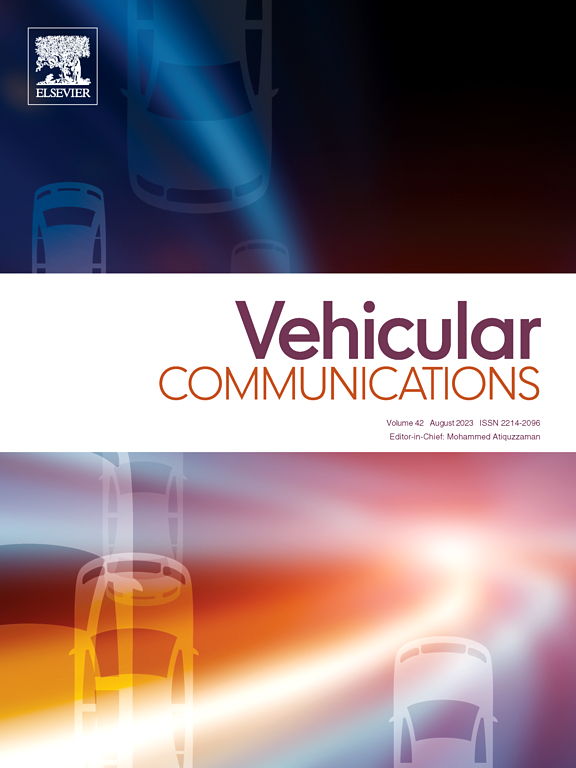On the performance of a UAV-based Malaga-distributed FSO/FSO communication system with NOMA
IF 6.5
2区 计算机科学
Q1 TELECOMMUNICATIONS
引用次数: 0
Abstract
Non-Orthogonal Multiple Access (NOMA) is an efficient communication technique that can offer improved spectral efficiency, ultra-low latency and massive connectivity and its integration with Free Space Optical (FSO) communication can improve the network capacity to a great extent. In this manuscript, an Unmanned Aerial Vehicle (UAV) is employed as a relay in an FSO/FSO downlink network, comprising of two users, user 1, U1 and user 2, U2, using Amplify-and-Forward (AF) protocol. UAVs can prove to be assets in disaster-struck situations (during natural disasters such as earthquakes, floods, etc.), when all terrestrial communication is at halt. The performance of this system is determined in the presence of atmospheric attenuation, Malaga () turbulence fading, pointing errors and Angle-of-Arrival (AoA) fluctuations. Heterodyne detection (HD) technique is used for information detection at the users for providing improved sensitivity and Signal-to-Noise Ratio (SNR). The closed-form expressions for Outage Probability (OP), Ergodic Capacity and Bit Error Rate (BER) are derived in terms of Meijer-G function and OP is analyzed with respect to different weather conditions, turbulence levels, pointing error coefficients, NOMA coefficients and Field-of-View (FoV) angles. It is observed that at an SNR of 0 dB, the outage at U1 and U2 is 0.5489 and 0.7423, respectively. A comparison of OP is presented for the cases of HD and Intensity Modulation/Direct Detection (IM/DD) techniques and for NOMA and Orthogonal Multiple Access (OMA) technologies. Ergodic Capacity is analyzed for different turbulence strengths and pointing error values and it can be noticed that it is enhanced by reducing the turbulence strength and pointing error impairment. BER is observed for different modulation schemes and it is found to be , , and , for QPSK, 8-PSK, 16-PSK and 16-QAM, respectively, at an SNR of 30 dB. In addition, BER is analyzed for clear, rainy and foggy weather along with different pointing errors and turbulence regimes. Monte-Carlo simulations are also carried out in order to validate the correctness of the obtained analytical results.
基于NOMA的无人机马拉加分布式FSO/FSO通信系统性能研究
非正交多址(NOMA)是一种高效的通信技术,能够提供更高的频谱效率、超低延迟和海量连接,它与自由空间光通信(FSO)相结合,可以在很大程度上提高网络容量。在本文中,使用一架无人机(UAV)作为FSO/FSO下行网络中的中继,该网络由两个用户组成,用户1 U1和用户2 U2,使用放大转发(AF)协议。在所有地面通信中断的情况下,无人机可以被证明是灾害袭击的资产(在地震、洪水等自然灾害期间)。该系统的性能是在大气衰减、马拉加(M)湍流衰落、指向误差和到达角(AoA)波动的情况下确定的。外差检测(HD)技术用于用户处的信息检测,以提高灵敏度和信噪比。用Meijer-G函数导出了停运概率(OP)、遍历容量(Ergodic Capacity)和误码率(BER)的封闭表达式,并分析了OP在不同天气条件、湍流程度、指向误差系数、NOMA系数和视场角(FoV)的影响。可以观察到,在信噪比为0 dB时,U1和U2的中断分别为0.5489和0.7423。比较了高清和强度调制/直接检测(IM/DD)技术以及NOMA和正交多址(OMA)技术的OP。分析了不同湍流强度和指向误差值下的遍历能力,发现减小湍流强度和指向误差值可以提高遍历能力。在30 dB的信噪比下,QPSK、8-PSK、16-PSK和16-QAM的误码率分别为7.7×10−3、1.9×10−2、7.9×10−2和2.8×10−2。此外,还分析了晴空、雨天和雾天以及不同指向误差和湍流状态下的误码率。为了验证所得分析结果的正确性,还进行了蒙特卡罗仿真。
本文章由计算机程序翻译,如有差异,请以英文原文为准。
求助全文
约1分钟内获得全文
求助全文
来源期刊

Vehicular Communications
Engineering-Electrical and Electronic Engineering
CiteScore
12.70
自引率
10.40%
发文量
88
审稿时长
62 days
期刊介绍:
Vehicular communications is a growing area of communications between vehicles and including roadside communication infrastructure. Advances in wireless communications are making possible sharing of information through real time communications between vehicles and infrastructure. This has led to applications to increase safety of vehicles and communication between passengers and the Internet. Standardization efforts on vehicular communication are also underway to make vehicular transportation safer, greener and easier.
The aim of the journal is to publish high quality peer–reviewed papers in the area of vehicular communications. The scope encompasses all types of communications involving vehicles, including vehicle–to–vehicle and vehicle–to–infrastructure. The scope includes (but not limited to) the following topics related to vehicular communications:
Vehicle to vehicle and vehicle to infrastructure communications
Channel modelling, modulating and coding
Congestion Control and scalability issues
Protocol design, testing and verification
Routing in vehicular networks
Security issues and countermeasures
Deployment and field testing
Reducing energy consumption and enhancing safety of vehicles
Wireless in–car networks
Data collection and dissemination methods
Mobility and handover issues
Safety and driver assistance applications
UAV
Underwater communications
Autonomous cooperative driving
Social networks
Internet of vehicles
Standardization of protocols.
 求助内容:
求助内容: 应助结果提醒方式:
应助结果提醒方式:


